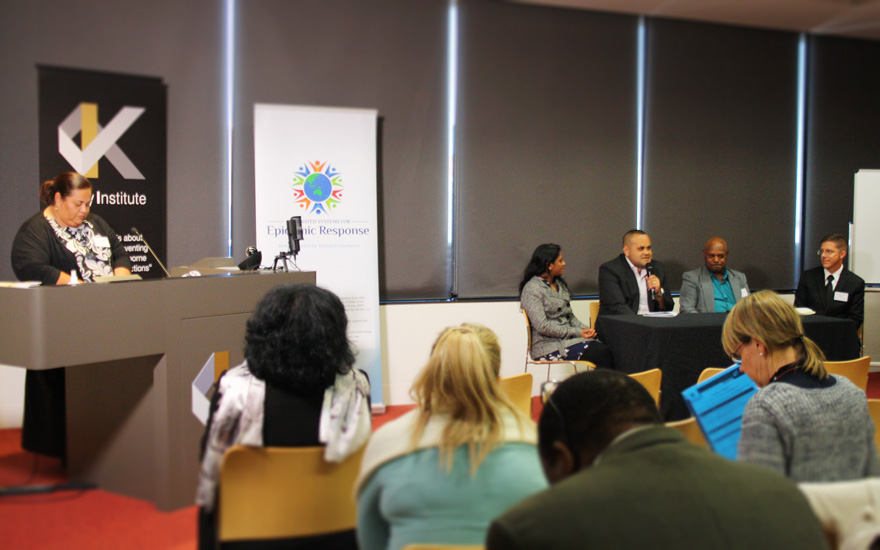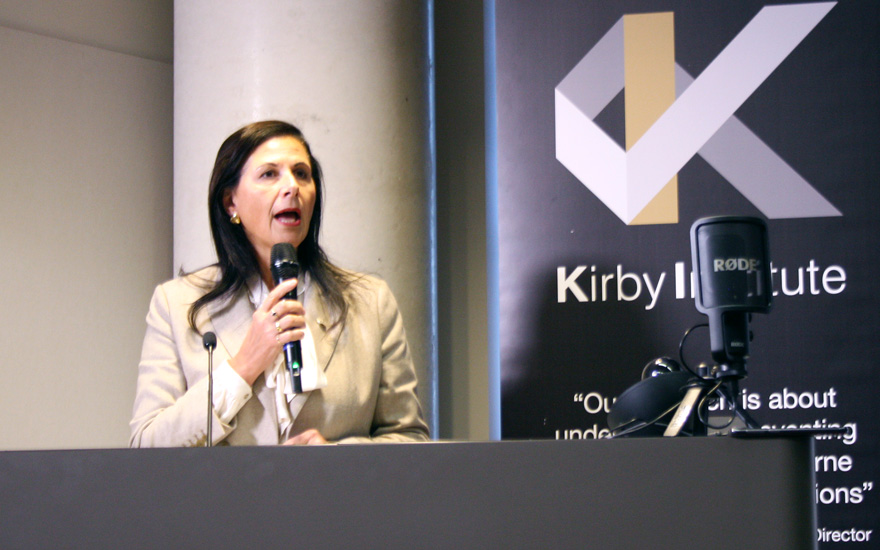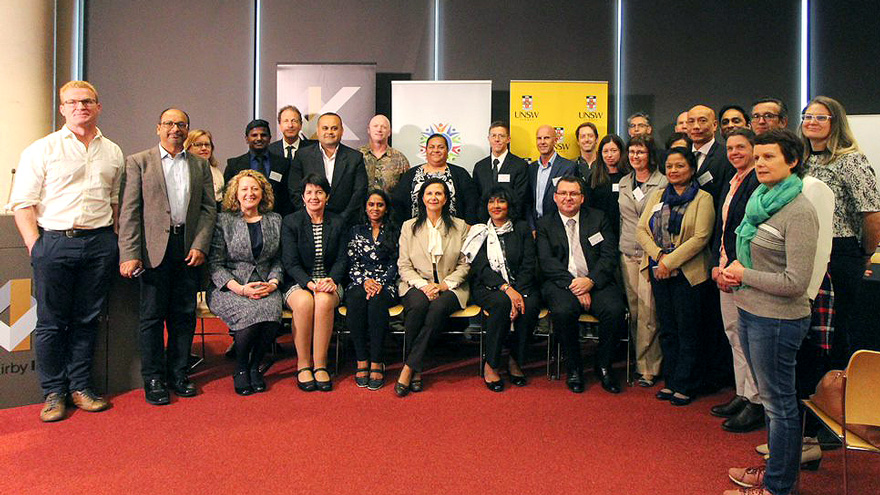(SYDNEY, Tuesday 21 August 2018) Preparedness could be the difference between a contained local outbreak and a global pandemic if there was a smallpox attack in the Pacific today, a bioterrorism exercise held at UNSW Sydney discovered.
The hypothetical scenario, designed to test preparedness and response globally to a smallpox attack in our region, brought together key international representatives from departments of health, foreign affairs, defence, police, non-government agencies, vaccine manufacturers and other global stakeholders.

The simulation uncovered that for a disease as infectious as smallpox, every day counts. The most important determinants impacting the spread of the epidemic were finding and isolating people with smallpox, tracking their contacts and vaccinating them and the speed of response. How quickly different systems were able to work together to achieve this was critical.
A hypothetical outbreak of smallpox originating in Fiji was the focus of the scenario. The exercise was designed by Professor Raina MacIntyre from the Kirby Institute who is the head of the Centre for Research Excellence in Integrated Systems for Epidemic Response (ISER), with Associate Professor David Heslop from UNSW Medicine’s School of Public Health and Community Medicine and in conjunction with the Fiji Ministry of Health. The smallpox simulation incorporated lessons from real outbreaks and was based on previous UNSW research, but adapted to Fiji and the Pacific.
“The modelled death rate for smallpox may be as high as 45% if it emerged today,” said Professor MacIntyre. “Even though the world successfully eradicated smallpox in 1980, the disease has been on the radar again since scientists used mail order DNA to create a virus very similar to smallpox in a lab in 2017,” said Professor MacIntyre. “Smallpox is spread through the air, and is more than twice as infectious as influenza or Ebola. In the case of a biowarfare event, our modelling shows that without a rapid and coordinated response, the epidemic would quickly spiral out of control and become a pandemic.”
“There is very little immunity to smallpox in today’s population, so anyone who came into contact with smallpox would need to be vaccinated within three to four days of contact to reduce the risk of serious infection and death,” said Professor MacIntyre. “Our coordinated regional response should start within seven days of identifying the first case to ensure the best possible outcome and early termination of the epidemic.”
In the event of global spread, first responders would need to isolate 70% of smallpox patients and track and vaccinate at least 70% of their contacts. If this drops to less than 53%, it would take over four years and 2 billion doses of vaccine to bring the epidemic under control. The existing World Health Organisation stockpile contains 35 million doses of vaccine. The vaccine could be diluted in such an emergency, but resources to effect large scale isolation and quarantine would be the main problem.”
Associate Professor Heslop, who is also a Senior Medical Advisor for the Australian Defence Force, said these numbers highlight the need for a coordinated response across all levels of society.
“We looked at a worst-case scenario, because the purpose of an exercise like this is to prepare for the worst, while hoping for the best. It is a mammoth task to ensure that the health systems work in close partnership with military, police, emergency services, vaccine and drug manufacturers, the World Health Organisation and many other agencies,” said Associate Professor Heslop. “Whilst the probability of a smallpox attack may be low, the impact will be high, and so it is essential we prepare for these scenarios and know exactly what we can do to avoid the worst occurring.”

The forum was attended by Senator the Hon Concetta Fierravanti-Wells, Minister for International Development and the Pacific, who said: “The World Health Organisation has told us that it is not a case of if, but a case of when, another major pandemic [of natural or unnatural origin] will strike. This could devastate communities through loss of life, disrupt tourism, trade, investment and people movement, setting back regional economic growth and development. The $300 million Health Security Initiative for the Indo-Pacific region includes the largest health and medical research commitment ever made under Australia’s overseas development assistance program.”
The smallpox simulation was held from 16-17 August 2018, at UNSW Sydney, and coincides with new research from UNSW and the PLuS Alliance that shows how minimal genetic material could be used to rapidly identify severity and uncover global transmission routes.
This workshop was funded by the National Health and Medical Research Council (NHMRC) Centre for Research Excellence, Integrated Systems for Epidemic Response (ISER), along with Emergent Biosolutions and Bavarian Nordic. It was supported by Global Security PLuS.

It was attended by a number of key representatives from Australia, New Zealand, the USA, Fiji and other Pacific countries. Quotes from attendees are included below.
___________________________
Participant quotes:
“This exercise was a worst case scenario, but realistic. It showed how disastrous a large scale biological warfare attack in a crowded space and relatively impoverished nations could be. Preparation for such a disaster would help handle large scale outbreaks of such diseases as Ebola, SARS, or avian influenza, not just smallpox. The exercise underscored the importance of communication among nations, and training to handle major infectious disease outbreaks. The attendees found this was time well spent.”
Dr Michael Lane
Former Director of Smallpox Eradication at US CDC and Emeritus Professor, Emory University, USA
“This has been a vivid reminder that bioterrorism threats are on the radar, and has illustrated how a virus such as smallpox might behave in in a world where the population is immunologically vulnerable. One of the challenges is the myriad of scenarios that can unfold; whilst we cannot prepare totally for all of them, by working through individual case studies, we can produce the concepts and understand the science of working with multidisciplinary teams to prepare for these kind of threats.”
Professor Michael Baker
University of Otago, Wellington NZ
“Fiji needs to consider a coordinated cross-sector response that covers vaccination, quarantine, isolation, hospital capacity, travel, first responders, workforce and critical infrastructure. We’ve learned that policy assumptions about available resources domestically and overseas may not hold under certain circumstances”.
Dr Devina Nand
Fiji Ministry of Health
“Yesterday’s workshop highlighted the issue of surge capacity. Laboratories and diagnosis can often get left behind, so it is vital that we understand that smallpox is one of many issues in which we must maintain capacity and knowledge around research and development, because this is an area that is changing very quickly. The other thing that has arisen here is that infrastructure must be tailored to address threats present in diverse circumstances, particularly the threat of a major health crisis in a resource-limited country.”
Professor Bill Rawlinson
Medical Virologist from NSW Health Pathology / Conjoint at UNSW
“This workshop highlighted the reality of a bioterrorism threat, and the catastrophic consequences one such as this could have not just locally, but globally. It was pleasing to see the range of people from different disciplines and different stakeholder groups in the room, committed to preparing as best as possible for the potential act of bioterrorism occurring and responding to it in a way that minimises loss of life. There was an acceptance that terrorism, in any form, is not just the responsibility for law enforcement and intelligence agencies, but that combatting these threats requires a whole of society approach.”
Senior law enforcement and counter-terrorism delegate
"The workshop was based on a well-thought scenario supported by modelling and used innovative ways to interact with the audience. It was an excellent opportunity for discussions about epidemic response with participants from the Pacific Islands and from Australia. The wide range of perspectives gave an additional dimension, with contributions from police and defence authorities who were also represented at the workshop. As there is a renewed interest in epidemic response in the Pacific Islands in the context of regional health security, the workshop helped foster thinking about collaborative approaches in this area."
Dr Tom Kiedrzynski
Principal Advisor, Communicable Diseases, Ministry of Health, New Zealand
“We need better methods to detect and track outbreaks. Tracing outbreaks in near real-time using genomics is almost a reality. In the event of a smallpox outbreak, understanding the accuracy and limitations of modelling methods that use minimal genetic material could mean critical resources are directed to the right places at the right time."
Mr Dillon Adam
Lead author / PhD student, Biosecurity Program, Kirby Institute, UNSW Sydney
“In a globalized world, disease pathogens do not carry national passports, neither do they respect state sovereignty. The International Health Regulations (IHR) offer an opportunity for effective governance of emerging and re-emerging epidemics and pandemics in an interdependent world”.
Obijiofor Aginam
Deputy Director, International Institute for Global Health, United Nations University, Kuala Lumpur, Malaysia
“Phylogeography is a discipline that can inform public health surveillance. We show that in our latest research study by focusing on select smallpox genes. This virus still represents a serious concern among epidemiologists and hopefully this work will help us in a response, if ever needed.”
Associate Professor Matthew Scotch
Arizona State University
"We have seen in today's exercise that safeguarding the population against public health threats, whether by accidental, intentional, or naturally occurring causes, requires coordinated strategies at the national level. Collaboration across stakeholders and input from experts from government, defence agencies, academia, industry, first responder groups, healthcare providers, community partners, vaccine manufacturers, and others are key to prepare for, prevent, and protect against these threats. It is vitally important for all countries to have a preparedness plan for such untoward events."
Dr. Kevin Yeo, MBBS
Director, Clinical & Medical Affairs, Emergent BioSolutions
“Modelling various outbreak scenarios is an important component of developing the continuum of biopreparedness. The smallpox scenario we explored these past days highlights the complexity and challenges when considering the capacity of our global systems to prepare for such an outbreak. This workshop has enabled a diverse and knowledgeable group of stakeholders to gather, and to ensure that together, we are moving in the right direction when it comes to responding to these bio threats in general terms, and willing to reflect and respond to this new normal with new thinking and new tools.”
Jesper Elsgaard, VP
Global Governmental Affairs, Bavarian Nordic
“I’m convinced more than ever of the need to have the ability for countries to have a rapid reaction force or infectious disease response group that can respond rapidly to emergent infectious diseases, particularly with smallpox as a worst-case scenario.”
Dr Craig Dalton
Conjoint Associate Professor, University of Newcastle / Coordinator of flu tracking
Contact
Estelle Jones, Communications Officer
Phone
+61 2 9385 9987